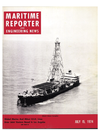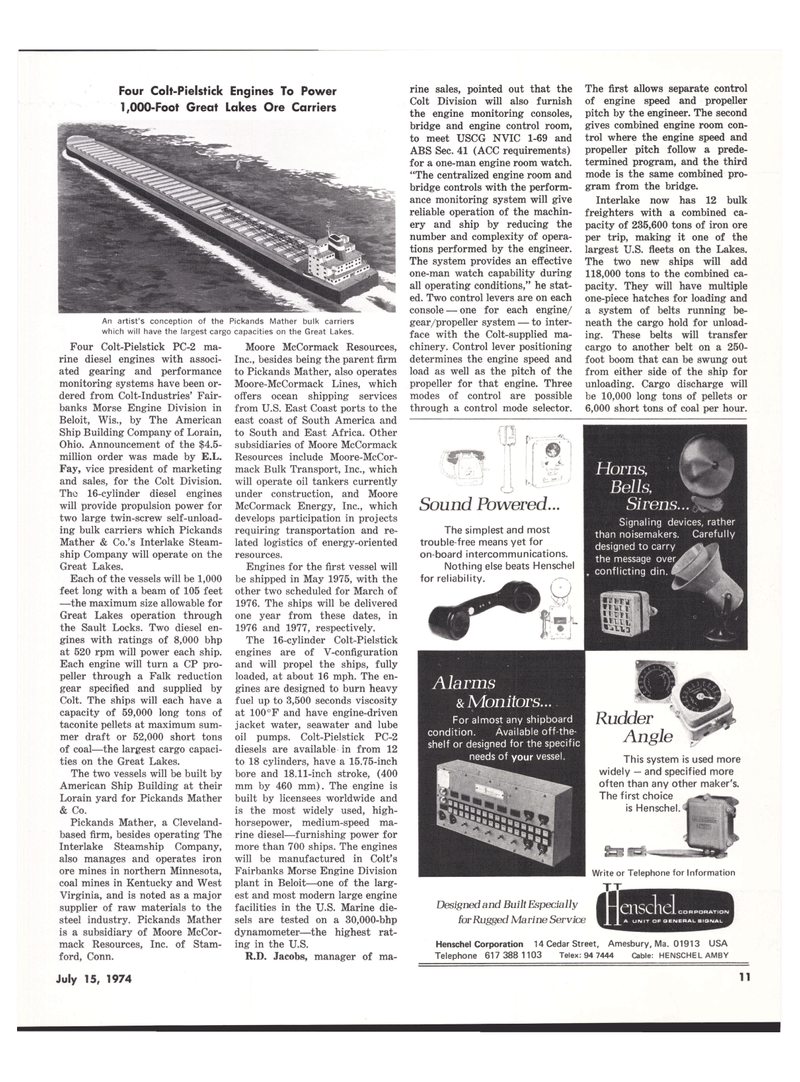
Page 9: of Maritime Reporter Magazine (July 15, 1974)
Read this page in Pdf, Flash or Html5 edition of July 15, 1974 Maritime Reporter Magazine
Four Colt-Pielstick Engines To Power 1,000-Foot Great Lakes Ore Carriers
An artist's conception of the Pickands Mather bulk carriers which will have the largest cargo capacities on the Great Lakes.
Four Colt-Pielstick PC-2 ma- rine diesel engines with associ- ated gearing and performance monitoring systems have been or- dered from Colt-Industries' Fair- banks Morse Engine Division in
Beloit, Wis., by The American
Ship Building Company of Lorain,
Ohio. Announcement of the $4.5- million order was made by E.L.
Fay, vice president of marketing and sales, for the Colt Division.
The 16-cylinder diesel engines will provide propulsion power for two large twin-screw self-unload- ing bulk carriers which Pickands
Mather & Co.'s Interlake Steam- ship Company will operate on the
Great Lakes.
Each of the vessels will be 1,000 feet long with a beam of 105 feet —the maximum size allowable for
Great Lakes operation through the Sault Locks. Two diesel en- gines with ratings of 8,000 bhp at 520 rpm will power each ship.
Each engine will turn a CP pro- peller through a Falk reduction gear specified and supplied by
Colt. The ships will each have a capacity of 59,000 long tons of taconite pellets at maximum sum- mer draft or 52,000 short tons of coal—the largest cargo capaci- ties on the Great Lakes.
The two vessels will be built by
American Ship Building at their
Lorain yard for Pickands Mather & Co.
Pickands Mather, a Cleveland- based firm, besides operating The
Interlake Steamship Company, also manages and operates iron ore mines in northern Minnesota, coal mines in Kentucky and West
Virginia, and is noted as a major supplier of raw materials to the steel industry. Pickands Mather is a subsidiary of Moore McCor- mack Resources, Inc. of Stam- ford, Conn.
Moore McCormack Resources,
Inc., besides being the parent firm to Pickands Mather, also operates
Moore-McCormack Lines, which offers ocean shipping services from U.S. East Coast ports to the east coast of South America and to South and East Africa. Other subsidiaries of Moore McCormack
Resources include Moore-McCor- mack Bulk Transport, Inc., which will operate oil tankers currently under construction, and Moore
McCormack Energy, Inc., which develops participation in projects requiring transportation and re- lated logistics of energy-oriented resources.
Engines for the first vessel will be shipped in May 1975, with the other two scheduled for March of 1976. The ships will be delivered one year from these dates, in 1976 and 1977, respectively.
The 16-cylinder Colt-Pielstick engines are of V-configuration and will propel the ships, fully loaded, at about 16 mph. The en- gines are designed to burn heavy fuel up to 3,500 seconds viscosity at 100°F and have engine-driven jacket water, sea water and lube oil pumps. Colt-Pielstick PC-2 diesels are available in from 12 to 18 cylinders, have a 15.75-inch bore and 18.11-inch stroke, (400 mm by 460 mm). The engine is built by licensees worldwide and is the most widely used, high- horsepower, medium-speed ma- rine diesel—furnishing power for more than 700 ships. The engines will be manufactured in Colt's
Fairbanks Morse Engine Division plant in Beloit—one of the larg- est and most modern large engine facilities in the U.S. Marine die- sels are tested on a 30,000-bhp dynamometer—the highest rat- ing in the U.S.
R.D. Jacobs, manager of ma- rine sales, pointed out that the
Colt Division will also furnish the engine monitoring consoles, bridge and engine control room, to meet USCG NVIC 1-69 and
ABS Sec. 41 (ACC requirements) for a one-man engine room watch. "The centralized engine room and bridge controls with the perform- ance monitoring system will give reliable operation of the machin- ery and ship by reducing the number and complexity of opera- tions performed by the engineer.
The system provides an effective one-man watch capability during all operating conditions," he stat- ed. Two control levers are on each console — one for each engine/ gear/propeller system — to inter- face with the Colt-supplied ma- chinery. Control lever positioning determines the engine speed and load as well as the pitch of the propeller for that engine. Three modes of control are possible through a control mode selector.
The first allows separate control of engine speed and propeller pitch by the engineer. The second gives combined engine room con- trol where the engine speed and propeller pitch follow a prede- termined program, and the third mode is the same combined pro- gram from the bridge.
Interlake now has 12 bulk freighters with a combined ca- pacity of 235,600 tons of iron ore per trip, making it one of the largest U.S. fleets on the Lakes.
The two new ships will add 118,000 tons to the combined ca- pacity. They will have multiple one-piece hatches for loading and a system of belts running be- neath the cargo hold for unload- ing. These belts will transfer cargo to another belt on a 250- foot boom that can be swung out from either side of the ship for unloading. Cargo discharge will be 10,000 long tons of pellets or 6,000 short tons of coal per hour. fff"| m K: * s.
Sound Powered...
The simplest and most trouble-free means yet for on-board intercommunications.
Nothing else beats Henschel for reliability.
Designed and Built Especially for Rugged Marine Service l! ENSCHEL
CORPORATION
A UNIT OF GENERAL 8IOIMAL
Henschel Corporation 14 Cedar Street, Amesbury, Ma. 01913 USA
Telephone 617 388 1103 Telex: 94 7444 Cable: HENSCHEL AMBY
Horns,
Bells,
Sirens... v #
Signaling devices, rather than noisemakers. Carefully designed to carry ^Ml the message ovei^fe conflicting din.
Rudder
Angle
Alarms & Monitors...
For almost any shipboard condition. Available off-the- shelf or designed for the specific ^(rieeds of your vessel. !
Write or Telephone for Information
This system is used more widely — and specified more often than any other maker's.
The first choice is Henschel.
July 15, 1974 11

 8
8

 10
10
